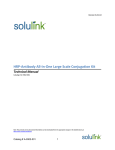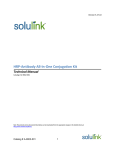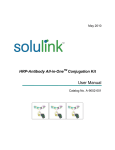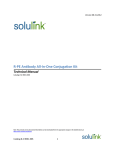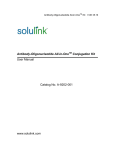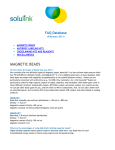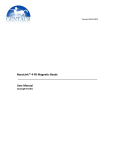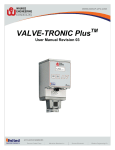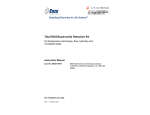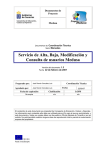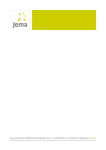Download HRP-Antibody All-in-One Conjugation Kit User Manual
Transcript
※本プロトコールは参考用の資料になり ます。商品ご購入の際は必ず商品に添付 されている資料をご参照ください。 HRP-Antibody All-in-One Conjugation V.05.27.10 HRP-Antibody All-in-OneTM Conjugation Kit User Manual Catalog No. A-9002-001 Table of Contents Chapter 1: Introduction ........................................................................................................................ 5 A. B. C. D. User Manual ...................................................................................................................................... 5 Purpose of Manual ............................................................................................................................ 5 Intended Users .................................................................................................................................. 5 Customer Service and Technical Support .......................................................................................... 5 Chapter 2: Overview of Conjugation .................................................................................................. 6 A. Product Description ........................................................................................................................... 6 B. All-in-One Technology ....................................................................................................................... 6 C. All-in-OneTM Conjugation Process Summary...................................................................................... 9 D. Materials Provided and Storage Conditions .................................................................................... 10 E. Additional Materials Required But Not Provided ............................................................................ 10 Chapter 3: All-in-OneTM Conjugation Protocol ............................................................................... 11 A. IgG Sample Preparation (10 minutes) ............................................................................................. 11 B. Buffer Exchange IgG (3 minutes) ..................................................................................................... 11 C. HyNic Modify IgG (2 hours) ............................................................................................................. 12 D. Buffer Exchange IgG (3 minutes) ..................................................................................................... 13 E. Conjugate Formation (2 hours) ....................................................................................................... 13 F. Buffer Exchange Conjugate (3 minutes) .......................................................................................... 14 G. Q Spin Column Purification (40 minutes) ........................................................................................ 14 H. Buffer Exchange Conjugate (3 minutes) .......................................................................................... 15 Chapter 4: Appendix............................................................................................................................ 17 A. B. C. D. E. F. G. H. I. J. K. Polyclonal & Monoclonal IgG-HRP Conjugates: Some Examples .................................................... 17 Direct ELISA Assay Using an IgG-HRP All-in-OneTM Conjugate......................................................... 18 Bradford Protein Assay .................................................................................................................... 19 Using a NanoDropTM to Measure Antibody Concentration ............................................................. 21 HRP Absorption Spectrum (Unmodified Horseradish peroxidase) ................................................. 23 4FB-modified HRP Absorption Spectrum ........................................................................................ 23 Bovine IgG-HRP Conjugate Absorption Spectrum (All-in-OneTM Purified) ...................................... 24 Concentration of Dilute Antibody Solutions.................................................................................... 24 Troubleshooting Guide .................................................................................................................... 26 Component Stability on Storage ..................................................................................................... 27 References ....................................................................................................................................... 28 2 The products offered here are for research use only. Any commercial application will require a license from Solulink. The Solulink Conjugation System is patented and has multiple patents pending. Please contact Solulink for information regarding licensing information. Solulink products and methods may be covered by one or more of the following United States patents Nos. 6,686, 461, 6,800,728, 7,102,024, 7, 173, 125, 7, 462, 689 and other pending patent applications. Information in this manual is subject to change without notice and does not constitute a commitment on the part of Solulink, Inc. It is supplied on an “as is” basis without any warranty of any kind, either explicit or implied. Information may be changed or updated in this manual at any time. This document may not be copied, transferred, reproduced, disclosed, or duplicated, in whole or in part, without the prior written consent of Solulink, Inc. This documentation is proprietary information and protected by the copyright laws of the United States and international treaties. The manufacturer of this documentation is Solulink, Inc. 2009 Solulink - The Conjugation Company, 9853 Pacific Heights Blvd. Suite H, San Diego, California 92121. All trademarks, trade names, service marks or logos referenced herein belong to their respective companies. No license is granted or implied to any patents to technologies for which the end user applies our products. For research purposes only. Not for diagnostic use 3 Safety Information WARNING – CHEMICAL HAZARD. Some chemicals used can be potentially hazardous, and can cause injury or illness. • Read and understand the Material Safety Data Sheets (MSDS) provided with this kit (flash drive) before you store, handle, or work with any chemicals or hazardous materials. • Minimize contact with and inhalation of chemicals. Wear appropriate personal protective equipment when handling chemicals (e.g. safety glasses, gloves, or clothing). For additional safety guidelines consult the MSDS. • Check regularly for chemical leaks or spills. If a leak or spill occurs, follow the manufacturer’s clean-up procedures as recommended in the MSDS. • Comply with all local, state/provincial, or national laws and regulations related to chemical storage, handling and disposal. 4 Chapter 1: Introduction A. User Manual This manual provides instructions for using the HRP-Antibody All-in-OneTM Conjugation Kit. This chapter contains the following sections: Purpose of Manual Intended Users Customer Service and Technical Support B. Purpose of Manual Each HRP-Antibody All-in-OneTM Conjugation Kit provides all the necessary reagents and components to produce two (2) HRP-antibody conjugates. Use of the kit (for each antibody) results in: • The modification of a user-supplied antibody (100 µg) with S-HyNic. • The conjugation of a HyNic-modified antibody with 4FB-HRP, resulting in the formation of an HRP-antibody conjugate. • The isolation of highly purified HRP-antibody conjugate using a rapid spin filter (Q spin filter) C. Intended Users The HRP-Antibody All-in-OneTM Kit is designed for users with minimal or no conjugation experience allowing them to prepare customized, high purity, ready-to-use HRPantibody conjugates in a single day. D. Customer Service and Technical Support Additional technical information can be found at: Telephone Email 1-888-625-0670 (Toll Free) [email protected] Fax Address 1-858-625-0770 Solulink-The Conjugation Company 9853 Pacific Heights Blvd, Ste H San Diego, CA 92121 5 Chapter 2: Overview of Conjugation A. Product Description Each HRP-Antibody All-in-OneTM Conjugation Kit provides all the necessary components to generate two (2) highly purified antibody-HRP conjugates. The kit requires the user to provide 100 µg of starting antibody for each conjugate. The components of this unique kit feature a pre-activated, high-activity horseradish peroxidase (>250U/mg) as well as a novel Q spin filter to purify the conjugate in high yield. Conjugates produced are free of both residual antibody and HRP, thus providing maximum signal to noise in your assay. Any suitably purified monoclonal or polyclonal mammalian antibody (regardless of IgG subclass) can be conjugated and purified within 5 hours (~1 h hands-on). All-in-OneTM conjugation kits are based on Solulink’s proven HydraLinkTM chemistry. This chemistry involves the reaction of an aromatic hydrazine with an aromatic aldehyde to form a stable hydrazone bond. HydraLinKTM conjugation is so efficient that it converts 100% of the antibody to the conjugate form. This linking efficiency is made possible because of the recent discovery that small quantities of aniline catalyze hydrazone bond formation between the two functional groups (1, 2, 3). Aniline increases both the rate and efficiency of conjugate formation under mild reaction conditions; leading to quantitative conversion of free antibody to HRP conjugate. Complete conversion of antibody to conjugate greatly simplifies downstream purification. Purification consists of selectively binding the conjugate to a novel Q spin filter membrane that allows excess HRP to flow through unbound. The spin filter provides high purity without sacrificing conjugate yield. Conjugates made with All-inOneTM kit are compatible with all downstream applications such as Westerns, ELISAs, or IHC. Each kit provides sufficient reagents to perform two (2) conjugation reactions; each yielding between 50-70 µg of high purity HRP-antibody conjugate. B. All-in-OneTM Technology 1) Conjugation Chemistry HydraLinKTM chemistry is based on the use of two complementary heterobifunctional linkers; S-HyNic and Sulfo-S-4FB (Figure 1). S-HyNic (Succinimidly-6-hydrazinonicotinamide) is first used to modify and incorporate protected aromatic hydrazines (HyNic groups) into the antibody via acylation of lysine residues. In a similar fashion a second linker, Sulfo-S-4FB (Sulfo-N-succinimidly-4-formylbenzamide) is used by Solulink to provide a pre-activated high activity HRP called 4FB-HRP (included). Incubation of HyNic-modified antibody with pre-activated 4FB-HRP in the presence of aniline catalyst leads to rapid and efficient conversion of the antibody to conjugate through formation of stable bis-arylhydrazone bonds (Figure 2). 6 Figure 1. Structure of S-HyNic and Sulfo-S-4FB linkers used for conjugating HRP to antibody. Figure 2. Aniline catalyzed conjugation of HyNic-modified antibody with preactivated 4FB-HRP. 7 2) Conjugate Purification The efficiency of aniline-catalyzed hydrazone bond formation greatly simplifies conjugate purification. Aniline’s ability to increase both the rate and efficiency of conjugate formation under mild reaction conditions leads to quantitative conversion of free antibody to conjugate. The complete absence of free antibody at the end of the catalyzed reaction leaves only two components; excess HRP and conjugate. After conjugation, a novel Q spin filter is used to selectively bind the conjugate based on known biophysical properties of IgG (4, 5) while allowing free HRP to flow through. Purified conjugate can then be eluted from the filter membrane free of both residual antibody and HRP in high yield (50-70 µg). IgG-HRP conjugate + Bind conjugate to Q Spin Filter free excess un-conjugated 4FB-modified HRP spin Bind conjugate to Q spin filter free HRP passes through Q Spin Filter Wash filter and discard wash spin Elute conjugate from filter spin 100% pure IgG-HRP conjugate Figure 3. Q spin filter purification of HRP-IgG conjugate. 8 C. All-in-OneTM Conjugation Process Summary IgG Buffer Exchange IgG (3 min) spin S-HyNic linker HyNic-modify IgG (2 h) + HyNic Excess S-HyNic spin Buffer Exchange IgG (3 min) 4FB 4FB-HRP Conjugate IgG to HRP (2 h) + Excess 4FB-HRP spin Purify Conjugate (45 min) spin Q Spin Column spin Purified IgG-HRP conjugate Figure 4. HRP-Antibody All-in-OneTM conjugation process. 9 D. Materials Provided and Storage Conditions Components S-HyNic 4FB-Modified HRP Buffer A Buffer B Buffer C Spin Column (Red cap) Spin Column (Yellow cap) Spin Column (Brown cap) Spin Column (Blue cap) Q Spin Filters Q Collection tubes DMF Amount 2 x 100 µg 2 x 50 µl 5 mL 5 mL 0.5 mL 2 2 2 2 2 4 0.5 mL Diafiltration Spin Filters (30k) Collection Tubes 2 16 Flash Drive 1 Storage conditions Keep refrigerated within desiccated sealed aluminum pouch Keep refrigerated (2-8oC) Keep refrigerated (2-8oC) Keep refrigerated (2-8oC) Keep refrigerated (2-8oC) Keep refrigerated (2-8oC) Keep refrigerated (2-8oC) Keep refrigerated (2-8oC) Keep refrigerated (2-8oC) Room temperature or refrigerated (2-8oC) Room temperature or refrigerated (2-8oC) Room temperature or refrigerated (2-8oC) Room temperature or refrigerated (2-8oC) Room temperature or refrigerated (2-8oC) Room temperature E. Additional Materials Required But Not Provided Bradford Protein Assay Reagents (verification of initial IgG concentration) Conventional UV-VIS or NanoDropTM Spectrophotometer (optional) Semi-micro quartz cuvette (50-100 µL, 1-cm path length) (For conventional UV-VIS Spectrophotometer) Calibrated pipettes (P-2 or P-10, P-100, P-1000) and tips Variable speed centrifuge (e.g. Eppendorf or MicroMax) 1.5 ml microfuge tubes 10 Chapter 3: All-in-OneTM Conjugation Protocol IMPORTANT- Before using the kit, remove from refrigerated storage and allow components to warm up to ambient or room temperature for at least 30 minutes. A. IgG Sample Preparation (10 minutes) Antibodies come in two physical forms, solids or liquids. Individual samples can vary significantly in the amount of packaged IgG (protein mass) and/or concentration (mg/ml). We highly recommend that IgG concentrations be confirmed either by Bradford protein assay or A280 whenever possible. The All-inOneTM conjugation protocol requires antibody samples to be free of protein carriers such as BSA or gelatin before proceeding. A 100 µg mass of antibody is required at the start of the procedure. Depending on the initial form of your sample (solid or liquid), proceed as follows: Antibody is in Solid Form (e.g. lyophilized powder) Resuspend lyophilized antibody (100 µg free of protein additives gelatin or BSA) in 25 µl Buffer A to obtain a 4 mg/mL solution. If the antibody sample contains less than 100 µg per vial (e.g. 50 µg), resuspend the requisite number of vials equivalent to a 100 µg in 25 µl Buffer A to obtain a 4 mg/mL solution. Proceed to step B below. Antibody is in Liquid Form (e.g. PBS or TBS Buffer) If the antibody sample is in liquid form at 4 mg/ml, simply transfer 25 µl to a labeled microfuge tube. If the sample is in liquid form at a concentration greater than 4 mg/ml, transfer a volume equivalent to 100 µg antibody to a labeled microfuge tube and add Buffer A to obtain 4 mg/ml solution. If a sample is at a concentration less than 4 mg/ml, concentrate the sample to 25 µL and 4 mg/mL using a diafiltration spin filter (e.g. Amicon or VivaSpin 500) as described in the Appendix. A concentration filter is provided in the kit for this purpose (if necessary). Proceed to step B below. B. Buffer Exchange IgG (3 minutes) 1. Prepare a spin column (red cap) by twisting off the bottom closure and loosening the red cap (do not remove). Place the spin column into a collection tube (provided). 11 2. Mark the top of the red cap using an indelible pen to identify the sample and place a vertical mark on the side of each spin column as shown on the next page. 3. Place the assembly into the centrifuge and orient the vertical mark on the spin column aiming outward and away from the center of the rotor. 4. Centrifuge at 1,500 x g for 1 minute. Discard the flow through from the collection tube. The column matrix will appear white in color. Place the column back into a new, empty collection tube (provided). 5. Remove the red cap; load the antibody sample (25 µL at 4 mg/mL) to the top of the dry resin bed; loosely recap and place the column back into the collection tube. 6. Orient the spin column mark outward as before and centrifuge at 1,500 x g for 2 minutes. Use an appropriate balance tube opposite the assembly. Important- Rotor speed must be set to 1500 x g (RCF) and not 1500 x rpm (RPM). The volume recovered should always be approximately the same volume loaded onto the spin column (e.g. 25 + 5 µL). If the recovered volume is low, the centrifuge may require recalibration. If recovered volume is low; re-centrifuge at the appropriate speed in an attempt to recover the full volume (i.e. 25 µL). 7. Transfer the buffer exchanged IgG solution (25-30 µL) from the bottom of the collection tube to a new 1.5 mL tube and label appropriately. C. HyNic Modify IgG (2 hours) 1. Add 20 µl DMF to the vial of S-HyNic reagent. Pipette the solution up and down to resuspend the reagent pellet. Note- a small but visible pellet can be seen at the bottom of the vial. 2. Add 1.5 µl dissolved S-HyNic reagent to the antibody solution (25 µl @ ~ 4 mg/mL). Pipette the solution up and down to mix. 3. Incubate the reaction for 2 h at room temperature. 12 D. Buffer Exchange IgG (3 minutes) 1. Five minutes before the end of the HyNic modification reaction (section c step 3), prepare a spin column (yellow cap) by twisting off the bottom closure and loosening the yellow cap (do not remove). Place the spin column into a collection tube (provided). 2. Mark the top of the yellow cap using an indelible pen to identify the sample. Also place a vertical mark on the side of each spin column as shown on the next page. Label the lid w/sample ID Place pen mark on Side of spin column Collection tube 3. Place the assembly into the centrifuge and orient the vertical mark on the spin column aiming outward and away from the center of the rotor. Use an appropriate balance tube opposite the assembly. 4. Centrifuge at 1,500 x g for 1 minute. Discard the flow through from the collection tube. The column matrix will appear white in color. Place the column back into a new, empty collection tube (provided). 5. Open the yellow cap; load the now completed antibody/HyNic modification reaction (~ 25-35 µL) to the top of the dry resin bed; loosely cap and place the column back into the collection tube. 6. Orient the spin column mark outward and use an appropriate balance tube opposite the spin filter. Centrifuge at 1,500 x g for 2 minutes. 7. After centrifugation, transfer the solution (~ 25-35 µL) from the bottom of the collection tube to a 1.5 mL tube. Label the sample appropriately (e.g. HyNicIgG). E. Conjugate Formation (2 hours) 1. Briefly spin the dark brown vial containing 4FB-modified HRP (5 seconds @ 1000 x g) to collect the contents at the bottom of the tube. 2. Transfer 50 µl 4FB-modified HRP to the tube containing HyNic-modified antibody (25-35 µL); pipette up and down to mix. 3. Incubate the reaction for 2 h at room temperature to form the conjugate. 13 F. Buffer Exchange Conjugate (3 minutes) 1. After completion of the conjugation reaction, prepare a spin column (brown cap) by twisting off the bottom closure and loosening the brown cap (do not remove). Place the spin column into a collection tube (provided). Remember- equilibrate all kit components to ambient room temperature before use. 2. Mark the top of the brown cap using an indelible pen to identify the sample. Also place a vertical mark on the side of each spin column as shown below. Label lid w/conjugate ID Place pen mark on side of spin column Collection tube 3. Place the assembly into the centrifuge and orient the vertical mark on the spin column aiming outward and away from the center of the rotor. Use an appropriate balance tube opposite the spin filter 4. Centrifuge at 1,500 x g for 1 minute. Discard the flow through from the collection tube. The column matrix will appear white in color. Place the column back into a new, empty collection tube (provided). 5. Open the brown cap; load ~75-90 µL conjugate solution (section e, step 3) to the top of the dry resin bed; loosely cap and place the column back into the collection tube. 6. Orient the spin column mark outward and centrifuge at 1,500 x g for 2 minutes. 7. After centrifugation, add 350 µL Buffer B to the conjugate solution located at the bottom of the collection tube and pipette up and down to mix. Set aside on the bench for the time being. G. Q Spin Column Purification (40 min) 1. Pre-wet a Q Spin Filter (refer to next page) by adding 200 µL Buffer B to the top of the filter unit and incubate for 2 minutes. 14 filter unit collection tube 2. Place the filter assembly into the centrifuge and orient the letter Q towards the center of the rotor; spin at 2,000 x g for 4 minutes using an appropriate balance tube; discard the flow-through from collection tube and place the filter back into the empty collection tube. 3. Load the antibody-HRP conjugate (~430-450 µL) from the previous section (section f, step 7) to the top of the filter unit and allow it to incubate inside the filter for 2 minutes on the bench top. 4. Place the oriented assembly in the centrifuge and spin at 2,000 x g for 4 minutes using an appropriate balance tube opposite the filter unit; discard the flow-through from the bottom collection tube and place the filter back into the empty collection tube. Note- a light brown coloring will appear on the top of the Q filter membrane (bound conjugate). 5. Add 400 µL Buffer B to the filter unit; orient and balance in the centrifuge and spin at 2,000 x g for 4 minutes; discard the flow-through from the bottom collection tube and place the filter back into the empty collection tube. 6. Repeat step 5 two (2) additional times to complete the washing procedure. 7. Remove the top filter unit from the collection tube and place it into a new collection tube (provided) 8. Add 100 µL Buffer C to the top of the brown-colored filter membrane and incubate for 5 minutes on the bench top. 9. Place the oriented assembly in the centrifuge and balance, spin at 2,000 x g for 4 minutes; add an additional 50 µL Buffer C to the top of the filter membrane and spin the oriented assembly for another 4 minutes at 2,000 x g. A slightly brown-colored conjugate solution (150 µL) will now be visible at the bottom of the collection tube. Set the collection tube aside on the bench. H. Buffer Exchange Conjugate (3 minutes) 1. Prepare a spin column (blue cap) by twisting off the bottom closure and loosening the blue cap (do not remove). Place the spin column into a collection tube (provided). 2. Mark the top of the blue cap using an indelible pen to identify the sample. Place a vertical mark on the side of each spin column as shown on the next page. 15 3. Place the assembly into the centrifuge and orient the vertical mark on the spin column aiming outward and away from the center of the rotor. Use an appropriate balance tube opposite the spin filter 4. Centrifuge at 1,500 x g for 1 minute. Discard the flow through from the collection tube. The column matrix will appear white in color. Place the column back into a new, empty collection tube (provided). 5. Remove the blue cap; load 150 µL conjugate from the bottom of the Q spin filter collection tube (section g, step 9) to the top of the dry resin bed; loosely recap and place the column back into the collection tube. 6. Orient the spin column mark outward as before and centrifuge at 1,500 x g for 2 minutes. 7. After centrifugation, transfer the buffer exchanged conjugate (150 µL) from the bottom of the collection tube to a new 1.5 mL tube and label appropriately. 8. Measure the final protein concentration of the purified conjugate using either a Bradford or BCA protein assay (see Appendix). 16 Chapter 4: Appendix A. Polyclonal & Monoclonal IgG-HRP Conjugates: Some Examples Figure 5. Coomassie-stained (4-12% SDS-PAGE) gels illustrating typical conjugation results. Note- horseradish peroxidase is a 44 kD highly glycosylated protein that migrates as a broad band when the protein sample is not heated (70oC) before loading on an SDS-PAGE gel. 17 B. Direct ELISA Assay Using an IgG-HRP All-in-One Conjugate Figure 6. Direct ELISA curves generated using an HRP conjugate made with the All-inOne kit. A mouse anti-FITC monoclonal antibody was conjugated to HRP as described in the manual. Antigen consisting of FITC-labeled BSA (FITC MSR = 2) was coated on plates in a 2-fold dilution series (100 µl @ 500, 250, 125, 62.5, 31.25, 15.625, 7.8, 3.90, and 1.95 ng/ml) using standard methods. Immobilized antigen was then detected at 3 different conjugate concentrations (1 µg/ml. 0.5 µg/ml. 0.25 µg/ml) using TMB substrate (20 minutes @ 450 nm) on a Molecular Devices plate reader. 18 C. Bradford Protein Assay Solulink highly recommends that whenever IgG is not limiting or its concentration, source, or quality are unknown that the sample be assayed for initial protein concentration using a Bradford protein assay prior to conjugation. The starting quality and quantity of antibody is critical to the success of the procedure. A reference assay protocol is provided for measuring antibody or conjugate protein concentrations using Bradford protein reagents (not provided in the kit). Bradford Microtiter Plate Procedure Required Materials Bradford Reagent (Bio-Rad, Hercules, CA, Cat. #500-0006) 96-well microtiter plate (standard flat bottom) PBS (phosphate buffered saline) P-200 and P-1000 pipettes Bovine IgG Antibody Standard: 2 mg/ml (Pierce/ThermoFisher, Cat. # #23212) Molecular grade water Assay Protocol 1) Prepare 2 ml of a Bradford working solution by adding 400 µl dye reagent to 1600 µl molecular grade water (1:4 ratio). 2) Prepare the following protein dilution standards and blank as follows: Add 160 µl 2 mg/ml bovine IgG standard to 240 µl PBS (0.8 mg/ml standard) Add 150 µl 0.8 mg/ml standard to 50 µl PBS (0.6 mg/ml standard) Add 75 µl 0.6 mg/ml standard to 25 µl PBS (0.4 mg/ml standard) Add 50 µl 0.4 mg/ml standard to 50 µl PBS (0.2 mg/ml standard) Add 50 µl 0.2 mg/ml standard to 50 µl PBS (0.1 mg/ml standard) Add 50 µl PBS (buffer blank) 3) Pipette 5 µl of each standard (and blank) along with duplicates of antibody sample into separate microtiter wells. 4) Add 100 µl of previously diluted dye reagent (1:4) to each well and mix thoroughly. Always replace pipette tips between additions. 5) Incubate at room temperature for 5-10 minutes (but no more than 60 minutes). 6) Measure absorbance at 595 nm on a suitable microtiter plate reader. 7) A typical Bradford microtiter assay result from a commercial plate reader is illustrated below in Figure 7. 19 Figure 7. Print out from a Bradford microplate-based protein assay. 20 D. Using a NanoDropTM to Measure Antibody Concentration If an antibody sample is free of protein-based carriers (e.g. BSA, gelatin) or certain interfering preservatives such as thimerosal, then a simple non-destructive scan of the IgG sample on a NanoDropTM spectrophotometer can be used to estimate antibody concentration saving the trouble of conducting a Bradford protein assay to confirm concentration. To estimate antibody concentration using a NanoDropTM spectrophotometer, proceed as follows. 1. Turn on the NanoDropTM spectrophotometer and click on the NanoDropTM icon to launch the software. 2. Place a 2 µl drop of molecular grade water on the clean pedestal, click OK. 3. When the main menu appears, select the A280 menu option. Note- do not use the UV-VIS menu option on the NanoDropTM to read an antibody sample. 4. After the A280 menu appears, click-off the 340 nm normalization option using the mouse. Note-some instruments do not have this normalization feature in which case this step can be ignored. 5. In the window labeled Sample Type, select ‘Other protein E1%’ option from the pulldown menu. Enter the appropriate E1% value (Table 1 on the next page) corresponding to your particular antibody sample type. For example, 14.00 for mouse IgG. 6. Blank the NanoDropTM spectrophotometer by placing a 2 µl drop of the appropriate sample buffer (e.g. PBS) and click on the ‘Blank’ icon. 7. Immediately re-click the ‘Measure’ icon to validate the baseline (i.e. flat across the bandwidth). Clean the pedestal and repeat (if necessary) until a flat baseline is obtained. Note-sometimes air bubbles can become trapped on the pedestal during sample loading and cause baseline offsets. If necessary, remove air bubbles and rescan to insure a proper baseline. 8. Place a 2 µl volume of antibody solution on the clean pedestal and click the ‘Measure’ icon. Wait until the spectrum (220-350 nm) appears in the window. Notefor precious or limited samples the majority of the 2 µl aliquot can be recovered from the pedestal. 9. Record the antibody concentration directly from the NanoDropTM display window [mg/ml]. Alternately, calculate the antibody concentration (manually) as illustrated on the following page. 21 Example: A mouse IgG sample at 1 mg/ml in PBS (100 µl) was scanned as described and its concentration confirmed using equation #1 below. Figure 8. A mouse IgG sample 100 µl @ 1 mg/ml in PBS pH 7.2, scanned on the TM as described in the text. NanoDrop Sample Calculation Equation #1: [A280 /E1% value] x 10 mg/ml = protein concentration (mg/ml) E1% (mass extinction coefficient, from Table 1) Example: Mouse IgG @ 1 mg/ml (Fig. 8) A280 reading (from scan in Figure 8) = 1.34 Antibody E1% value (Table 1) = 14.00 [A280 / E1% bovine IgG] x 10 mg/ml = protein concentration (mg/ml) [1.34 / 14.00] x 10 mg/ml = 0.96 mg/ml Antibody Source Human IgG Human IgE Rabbit IgG Donkey IgG Horse IgG Mouse IgG Rat IgG Bovine IgG Goat IgG Antibody E1% (1-cm path) 13.60 15.30 13.50 15.00 15.00 14.00 14.00 12.40 13.60 Table 1. Mass extinction coefficients (E1%) used for calculating antibody concentrations. The E1% is the A280 of a 10 mg/ml solution in a 1-cm path. 22 E. HRP Absorption Spectrum (Unmodified Horseradish peroxidase) Figure 9. NanoDropTM absorption spectrum of unmodified horseradish peroxidase (220550 nm) @ 0.66 mg/ml (sodium phosphate buffer, pH 6.0, 1 mm path length) F. 4FB-modified HRP Absorption Spectrum Figure 10. NanoDropTM absorption spectrum of 4FB-modified horseradish peroxidase (220-550 nm) @ 0.66 mg/ml (sodium phosphate buffer, pH 6.0, 1 mm path length) 23 G. Bovine IgG-HRP Conjugate Absorption Spectrum (All-in-One Purified) Figure 11. NanoDropTM absorption spectrum of All-in-One IgG-HRP conjugate (220-550 nm) @ 0.96 mg/ml (sodium phosphate buffer, pH 6.0, 1 mm path length). H. Concentration of Dilute Antibody Solutions The HRP-Antibody All-in-One Conjugation protocol requires that initial antibody protein concentration be at 4-5 mg/ml and 25 µl. Many antibody vendors package their products at significantly more dilute concentrations (e.g. 0.25 to 1.5 mg/ml). In these instances, IgG samples will need to be concentrated to 4-5 mg/ml and 25 µl before proceeding. The All-in-One kit provides two (2) diafiltration filters (M.W.C.O. 30 kD) for this purpose (Figure 12). Carefully follow these instructions to avoid antibody loss or aggregation on the filter’s surface. Note-Dilute antibody solutions require at least 125 μg of starting antibody (e.g. 500 µl @ 0.25 mg/ml) since diafiltration filters recover ~80% of input antibody. If antibody samples are not inlimiting supply, we recommend antibody concentrations be confirmed using a Bradford protein assay before proceeding. Concentrator body Filtrate tube Figure 12. Diafiltration spin filter used for concentrating dilute antibody samples prior to the start of All-in-One conjugation protocol. 24 Antibody Concentration Protocol Note- the diafiltration spin filters illustrated is made to contain and process a maximum volume of 500 μl or less. If a volume greater than 500 μl is to be concentrated, multiple loadings will be required. 1) Open the lid of a diafiltration spin filter device. 2) Transfer 500 μl (or less) of dilute protein solution (equivalent to 125 μg antibody) to the center of the filter cup. 3) Close the lid and orient the spin filter in the centrifuge so that the volume markers face toward the center of the centrifuge rotor. Use an appropriate balance tube opposite the spin filter. 4) Centrifuge for 2 minutes @ 5,000 x g. Note-never centrifuge for longer periods of time 5) Open the filter unit and visually inspect the remaining volume. If the volume remaining in the concentrator body is greater than 25 μl, gently pipette the solution up and down to mix; taking care not to touch or puncture the filter surface during this step. 6) Repeat steps 4 and 5 until the volume in the filter cup reaches the 25 μl mark. Once the final volume reaches 25 μl, do not pipette up and down to avoid sample loss. Note-if the volume goes lower than 25 μl at this stage, add a small aliquot of Buffer A to bring the final volume to 25 μl. 7) Carefully transfer the concentrated IgG solution (25 μl) to a new 1.5 ml microfuge tube and proceed with the rest of the procedure in Chapter III, section B. 25 I. Troubleshooting Guide Problem Poor conjugate yield Possible Cause -initial antibody concentration and volume were incorrect or unknown. Recommended Action -whenever possible verify the original starting antibody concentration using a Bradford protein TM assay or NanoDrop to assure efficient conjugation. -concentrate or dilute the antibody sample to be conjugated into the required range (4-5 mg/ml and 25 µl) Poor conjugate yield Starting antibody concentration and volume are incorrect or unknown. -preservatives can interfere with the accuracy of a Bradford protein assay. Remove all interfering preservatives such as thimerosal or proclin before performing a Bradford protein assay. Poor HyNic modification -presence of protein carrier (e.g. BSA or gelatin) is contaminating the antibody sample. -remove and purify away all protein carriers such as BSA or gelatin using affinity chromatography or other methods Poor HyNic modification -improper mixing of HyNic reaction components -make sure to properly mix the antibody- HyNic reaction mixture -use a calibrated P-10 pipette to insure accuracy of small volumes -presences of amine contaminants -remove all non-protein amine contaminants such as glycine or Tris before modification -improper storage of S-HyNic reagent can lead to hydrolysis of this NHS ester -keep and store S-HyNic sealed in the aluminum pouch provided that contains dessicant. 26 -initial antibody concentration was too low or too high. measure the initial antibody concentration before proceeding (Bradford or NanoDrop) -concentrate or dilute the antibody sample into the recommend range (4-5 mg/ml and 25 µl) before proceeding Low conjugate and/or antibody recovery -low spin column recovery volume -use a properly calibrated variable-speed centrifuge Follow recommended spin speed/time. Altered spin speeds can adversely compromise protein and/or volume recovery J. Component Stability on Storage Component Stability Unopened Kit 1 yr Refrigerated (2-8 C) 1 yr Keep in sealed aluminum pouch o provided (2-8 C). S-HyNic o 24 h after re-suspending S-HyNic in DMF HRP-Antibody Conjugate All other kit components Flash Drive Storage Condition 9 month Room temperature o Refrigerated (2-8 C) in final conjugate solution. o 1 yr Refrigerated (2-8 C) (50% glycerol) 1 yr Refrigerated (2-8 C) 1 yr Room temperature o 27 K. References 1. Dirksen, A., Hackeng, T., Dawson, P.,(2007). Nucleophilic Catalysis of Oxime and Hydrazone Reactions by Aniline. ACS Poster 2. Dirksen, A., Hackeng, T., Dawson, P., (2006). Nucleophilic Catalysis of Oxime Ligations. Angew. Chem. Int. Ed. 45, 7581-7584 3. Dirksen, A., Dirksen, S., Hackeng, T., Dawson, P., (2006). Nucleophilic Catalysis of Hydrazone Formation and Transimination: Implications for Dynamic Covalent Chemistry. JIAICIS Communications. 4. Lim,S., Manusu, H.P., Gooley, A.A., Williams, K. L., Rylatt D.B.,(1998). Purification of monoclonal antibodies from ascitic fluid using preparative electrophoresis. Journal of Chromatography A. Vol. 827, Issue 2, 11, Pages 329335. 5. Chiodi,F., Sidén, A., Ösby, E., (2005). Isoelectric focusing of monoclonal immunoglobulin G, A and M followed by detection with the avidin-biotin system. Electrophoresis, Vol. 6 Issue 3, 124-128. 28




























